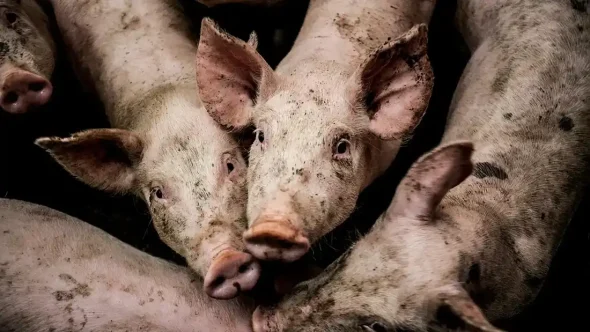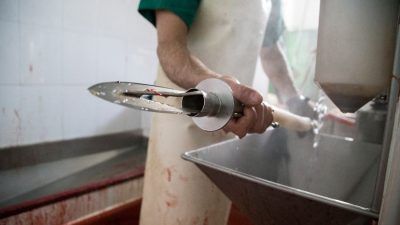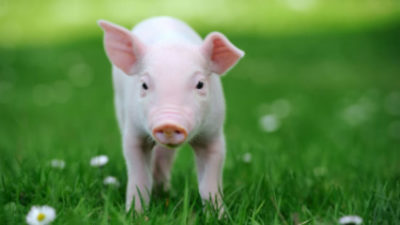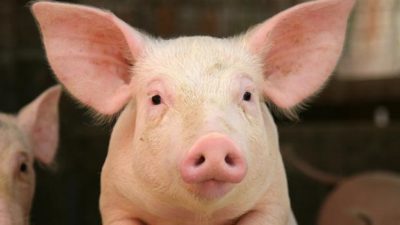Pig Gassing in the UK
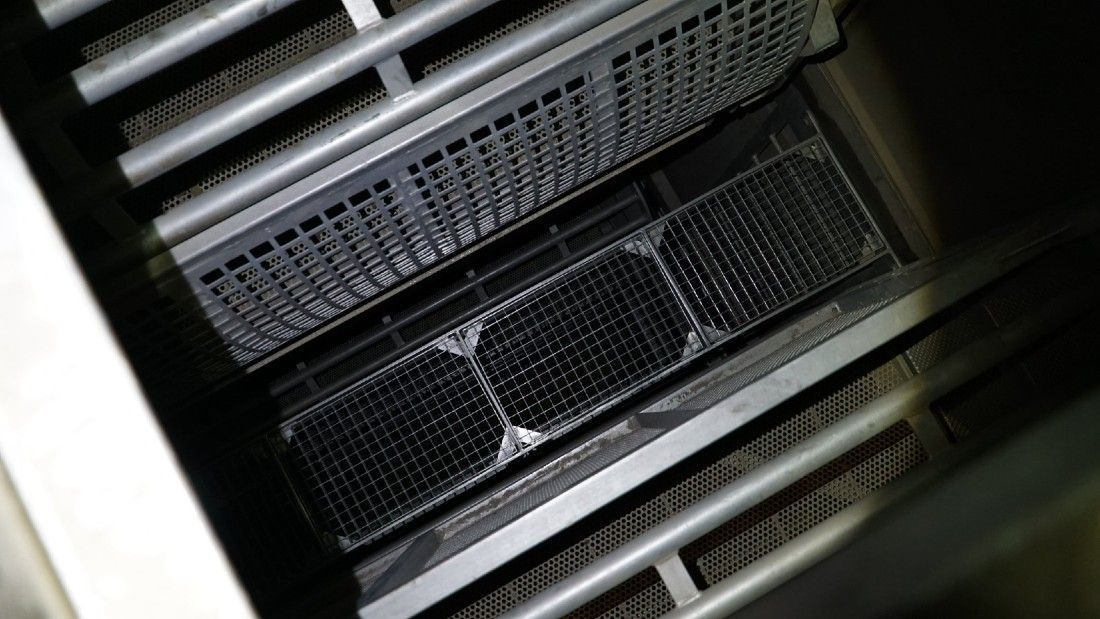
Almost 90 per cent of pigs in the UK are killed by gassing. It causes agony as the carbon dioxide gas forms an acid on their eyes, nostrils, mouths and lungs.
In the UK, almost 10 million pigs are slaughtered for meat every year.1Department for Environment, Food and Rural Affairs (Defra), 2022a. ‘Agriculture in the United Kingdom 2021. Defra. Available at https://www.gov.uk/government/statistics/agriculture-in-the-united-kingdom-2021/chapter-8-livestock [Accessed 8 February 2023]. Most of these highly intelligent sentient beings spend the majority of their miserable lives indoors; confined to filthy overcrowded sheds before heading to slaughter at just five to six months old.
Approved establishments
The Food Standards Agency (FSA) and Food Standards Scotland (FSS) are responsible for food safety and food hygiene in England, Wales, Northern Ireland and the latter in Scotland. They work with local authorities to enforce food safety regulations and ensure meat plants operate to the legal standard. Together, the FSA and FSS monitor over 250 slaughterhouses* – just under half of which have the means to slaughter pigs.
Stunning and slaughter
Prior to all standard (non-religious) slaughter, pigs are stunned; either through exposure to high concentration gas (which also kills them) or electronarcosis to the head (which is meant to stun the pig long enough for him or her to remain unconscious whilst being bled to death).
A slaughter survey, carried out between 7-13 March 2022, by the FSA2Department for Environment Food and Rural Affairs (Defra), 2022b. ‘Results of the 2022 FSA Slaughter Sector Survey in England and Wales’. Defra August. Available at https://assets.publishing.service.gov.uk/government/uploads/system/uploads/attachment_data/file/1096782/Results-of-the-2022-FSA-Slaughter-Sector-Survey-in-England-and-Wales.pdf [Accessed 6 February 2023]. indicates that in England and Wales 88 per cent of pigs are stunned with high concentration carbon dioxide (CO2); up from 86 per cent in 2018. Almost all the remaining 12 per cent are stunned by electronarcosis; a fully reversible procedure that disrupts normal brain function for a short period. Similar surveys are not carried out in Northern Ireland or Scotland.
Gas stunning is otherwise known as controlled atmospheric stunning and involves using an environment with a high concentration of gas, predominantly CO2, which causes an animal to lose consciousness and die. It takes roughly 90 seconds for pigs in a stunning chamber (see Direct Action Everywhere’s 3D reconstruction of a Marel stunning chamber below)3Greenburg, A., 2023. ‘Spy Cams Reveal the Grim Reality of Slaughterhouse Gas Chambers’. Wired 18 January. Available at https://www.wired.com/story/dex-pig-slaughterhouse-gas-chambers-videos/ [Accessed 6 February 2023]. to be rendered unconscious.4Wright, C., 2017. ‘Issues with Carbon Dioxide Stunning of Pigs’. The Pig Site 10 February. Available at https://www.thepigsite.com/articles/issues-with-carbon-dioxide-stunning-of-pigs [Accessed 9 February 2023].
*In January 2023, the FSA and FSS datasets listed 236 slaughterhouses in England and Wales, 19 in Northern Ireland and 24 in Scotland. Due to the changing nature of the industry (and seasonal slaughter establishments) these figures are regularly updated and published online at: https://www.food.gov.uk/business-guidance/approved-food-establishments

Pigs are herded into a gondola or carriage in groups of around six and then lowered into the gas chamber. It’s a paternoster style system with multiple gondolas, like a Ferris wheel. Once in the stunner, the animals must be conveyed to the maximum concentration of gas within 30 seconds of entering. Since CO2 is heavier than air, the maximum concentration is therefore always at the bottom.5European Food Safety Authority (EFSA), 2004. ‘Opinion of the Scientific Panel on Animal Health and Welfare on a request from the Commission related to welfare aspects of the main systems of stunning and killing the main commercial species of animals’. EFSA Journal, 45, 1-29. Available at https://efsa.onlinelibrary.wiley.com/doi/epdf/10.2903/j.efsa.2004.45 [Accessed 7 February 2023].6European Food Safety Authority (EFSA), 2020. ‘Welfare of pigs at slaughter’. EFSA Journal, 18(6):6148. Available at https://efsa.onlinelibrary.wiley.com/doi/epdf/10.2903/j.efsa.2020.6148 [Accessed 7 February 2023].7Humane Slaughter Association (HSA), 2018. ‘Carbon Dioxide Stunning and Killing of Pigs’. Humane Slaughter Association Technical Note No 19. Available at https://www.hsa.org.uk/downloads/technical-notes/tn19-carbon-dioxide-stunning-and-killing-of-pigs.pdf [Accessed 6 February 2023].
With most systems there will be at least one stop (due to more animals being loaded in or emptied out) before the pigs reach maximum concentration. This means that each part of the cycle should last no more than 25 seconds. Workers are required to make sure that no pig enters the gas stunner if the CO2 concentration by volume falls below 80 per cent.5European Food Safety Authority (EFSA), 2004. ‘Opinion of the Scientific Panel on Animal Health and Welfare on a request from the Commission related to welfare aspects of the main systems of stunning and killing the main commercial species of animals’. EFSA Journal, 45, 1-29. Available at https://efsa.onlinelibrary.wiley.com/doi/epdf/10.2903/j.efsa.2004.45 [Accessed 7 February 2023].6European Food Safety Authority (EFSA), 2020. ‘Welfare of pigs at slaughter’. EFSA Journal, 18(6):6148. Available at https://efsa.onlinelibrary.wiley.com/doi/epdf/10.2903/j.efsa.2020.6148 [Accessed 7 February 2023].7Humane Slaughter Association (HSA), 2018. ‘Carbon Dioxide Stunning and Killing of Pigs’. Humane Slaughter Association Technical Note No 19. Available at https://www.hsa.org.uk/downloads/technical-notes/tn19-carbon-dioxide-stunning-and-killing-of-pigs.pdf [Accessed 6 February 2023].8The Welfare of Animals at the Time of Killing (England) Regulations (WATOK), 2015. Available at https://www.legislation.gov.uk/uksi/2015/1782/contents/made [Accessed 7 February 2023].
As the gondola is lowered, the pigs will begin to show strong reactions – screaming and thrashing around violently trying to escape – for up to one minute.9Webster, B. and Colley, C., 2021. ‘Slaughterhouse pigs choke on gas meant to stun them’. The Times 19 January. Available at https://www.thetimes.co.uk/article/slaughterhouse-pigs-choke-on-gas-meant-to-stun-them-xvx22jrdx [Accessed 6 February 2023]. Exposure to CO2 gas leads to a loss of oxygen to the brain (anoxia). It forms an acid on the animals’ eyes, nostrils, mouths and lungs, and feels like burning from the inside out.5European Food Safety Authority (EFSA), 2004. ‘Opinion of the Scientific Panel on Animal Health and Welfare on a request from the Commission related to welfare aspects of the main systems of stunning and killing the main commercial species of animals’. EFSA Journal, 45, 1-29. Available at https://efsa.onlinelibrary.wiley.com/doi/epdf/10.2903/j.efsa.2004.45 [Accessed 7 February 2023].
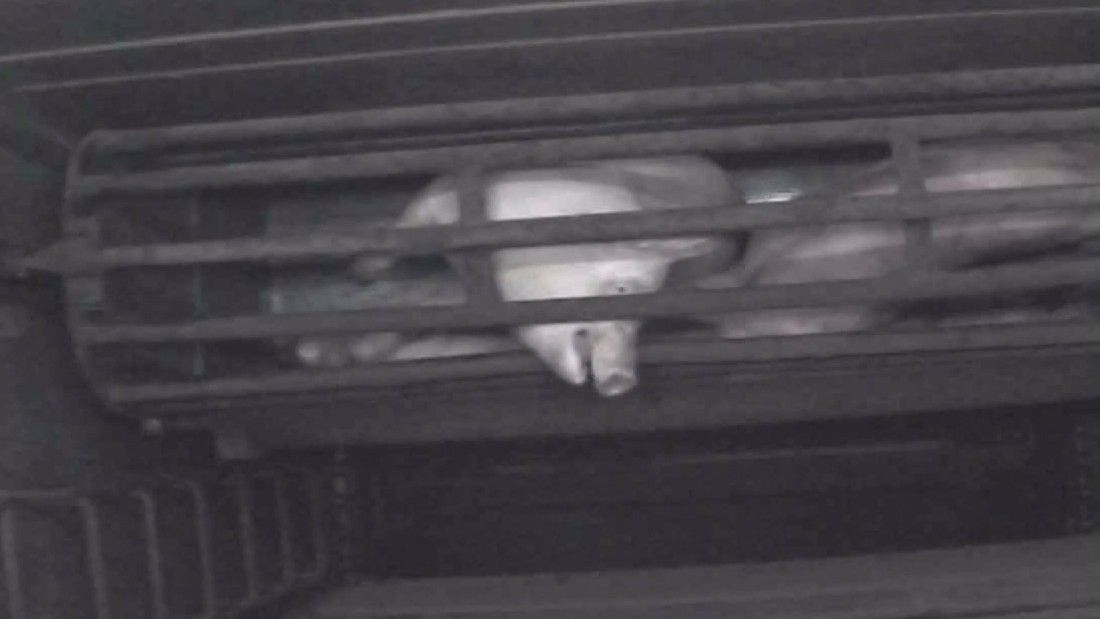
The Scientific Panel on Animal Health and Welfare of the European Food safety Authority5European Food Safety Authority (EFSA), 2004. ‘Opinion of the Scientific Panel on Animal Health and Welfare on a request from the Commission related to welfare aspects of the main systems of stunning and killing the main commercial species of animals’. EFSA Journal, 45, 1-29. Available at https://efsa.onlinelibrary.wiley.com/doi/epdf/10.2903/j.efsa.2004.45 [Accessed 7 February 2023]. states:
“[A]t concentrations above 30 per cent CO2, the gas is known to be aversive and cause hyperventilation and irritation of the mucous membranes that can be painful and elicits hyperventilation and gasping before loss of consciousness.”
Both the Farm Animal Welfare Council9Webster, B. and Colley, C., 2021. ‘Slaughterhouse pigs choke on gas meant to stun them’. The Times 19 January. Available at https://www.thetimes.co.uk/article/slaughterhouse-pigs-choke-on-gas-meant-to-stun-them-xvx22jrdx [Accessed 6 February 2023]10Farm Animal Welfare Council (FAWC), 2003. ‘Report on the welfare of farmed animals at slaughter or killing. Part 1: red meat animals’. Defra. Available at https://www.gov.uk/government/publications/fawc-report-on-the-welfare-of-farmed-animals-at-slaughter-or-killing [Accessed 7 February 2023]. and EFSA5European Food Safety Authority (EFSA), 2004. ‘Opinion of the Scientific Panel on Animal Health and Welfare on a request from the Commission related to welfare aspects of the main systems of stunning and killing the main commercial species of animals’. EFSA Journal, 45, 1-29. Available at https://efsa.onlinelibrary.wiley.com/doi/epdf/10.2903/j.efsa.2004.45 [Accessed 7 February 2023]. have recommended that stunning live conscious pigs with direct exposure to high concentration CO2 gas mixtures should be phased out.
High concentration CO2 does not result in instantaneous death. It takes two and a half minutes or more to eliminate the chance of a pig regaining consciousness. All pigs are gassed long enough to die. The law (The Welfare of Animals at the Time of Killing (England) Regulations) states:
“no person may stun pigs by exposure to gas unless each pig is exposed to the gas for long enough to ensure it is killed”.8The Welfare of Animals at the Time of Killing (England) Regulations (WATOK), 2015. Available at https://www.legislation.gov.uk/uksi/2015/1782/contents/made [Accessed 7 February 2023].
Therefore, sticking (cutting the throat) is not required.5European Food Safety Authority (EFSA), 2004. ‘Opinion of the Scientific Panel on Animal Health and Welfare on a request from the Commission related to welfare aspects of the main systems of stunning and killing the main commercial species of animals’. EFSA Journal, 45, 1-29. Available at https://efsa.onlinelibrary.wiley.com/doi/epdf/10.2903/j.efsa.2004.45 [Accessed 7 February 2023].6European Food Safety Authority (EFSA), 2020. ‘Welfare of pigs at slaughter’. EFSA Journal, 18(6):6148. Available at https://efsa.onlinelibrary.wiley.com/doi/epdf/10.2903/j.efsa.2020.6148 [Accessed 7 February 2023]. However, it is still carried out on all pigs after they have been killed, to bleed them out.
The meat industry claims that the advantage of high concentration gas over electrical stunning is that animals can be stunned in groups, with minimal handling or restraint.11Department for Environment Food and Rural Affairs (Defra), 2021. ‘Review of the Welfare of Animals at the Time of Killing (England) Regulations 2015’. Defra January. Available at https://assets.publishing.service.gov.uk/government/uploads/system/uploads/attachment_data/file/955031/welfare-animals-time-of-killing-regs-2015-post-implementation-review.pdf [Accessed 6 February 2023].6European Food Safety Authority (EFSA), 2020. ‘Welfare of pigs at slaughter’. EFSA Journal, 18(6):6148. Available at https://efsa.onlinelibrary.wiley.com/doi/epdf/10.2903/j.efsa.2020.6148 [Accessed 7 February 2023]. For large operations with high throughput rates, gas stunning is often the more reliable and consistent method as it reduces the chance of human error.7Humane Slaughter Association (HSA), 2018. ‘Carbon Dioxide Stunning and Killing of Pigs’. Humane Slaughter Association Technical Note No 19. Available at https://www.hsa.org.uk/downloads/technical-notes/tn19-carbon-dioxide-stunning-and-killing-of-pigs.pdf [Accessed 6 February 2023]. This is an admission that electrical stunning frequently fails, meaning animals regain consciousness when they are ‘stuck’ (knifed in the throat to bleed to death).
The use of argon or nitrogen gas mixes to induce hypoxia (lack of oxygen) have been proven to be non-aversive to pigs but CO2 gas has a direct anesthetic effect, which results in loss of consciousness more quickly.7Humane Slaughter Association (HSA), 2018. ‘Carbon Dioxide Stunning and Killing of Pigs’. Humane Slaughter Association Technical Note No 19. Available at https://www.hsa.org.uk/downloads/technical-notes/tn19-carbon-dioxide-stunning-and-killing-of-pigs.pdf [Accessed 6 February 2023]. CO2 gas is also cheaper than argon gas. This might be why argon is still not used commercially for stunning pigs.
High-expansion nitrogen foam has also been tested as an alternative way of administering a gas stun. The nitrogen foam purges the air from the container, quickly removing oxygen. A doctoral thesis by Pöhlmann12Pöhlmann V., 2018. ‘Untersuchung zur alternativen Betäubung von Schlachtschweinen mit einem hochexpansiven, Stickstoff-gefüllten Schaum unter Tierschutz-und Fleischqualitätsaspekten’. PhD thesis. Freie Universität, Berlin, Germany. evaluated the nitrogen foam method for stunning of slaughter-weight pigs. It found that exposure times of three and a half minutes to the nitrogen foam were not enough to assure unconsciousness and insensibility. Furthermore, animals were seen gasping and regaining sensibility shortly after stunning, leading to a high rate of re-stunning (22 per cent). Over two-thirds of the pigs tried to escape and in three-quarters of the pigs, foam residue was found in their lungs after slaughter.12Pöhlmann V., 2018. ‘Untersuchung zur alternativen Betäubung von Schlachtschweinen mit einem hochexpansiven, Stickstoff-gefüllten Schaum unter Tierschutz-und Fleischqualitätsaspekten’. PhD thesis. Freie Universität, Berlin, Germany.13Sindhøj, E., Lindahl, C. and Bark, L., 2021. ‘Review: Potential alternatives to high-concentration carbon dioxide stunning of pigs at slaughter’. Animal, 15 (3), 100164. Available at https://www.sciencedirect.com/science/article/pii/S175173112030166X?via%3Dihub [Accessed 7 February 2023].
Other studies have shown less aversive behaviour when the pigs were first exposed, but as the foam levels became high, they tried to avoid their heads and snouts being submerged. Escape attempts through the lid also increased when the foam started covering their heads.13Sindhøj, E., Lindahl, C. and Bark, L., 2021. ‘Review: Potential alternatives to high-concentration carbon dioxide stunning of pigs at slaughter’. Animal, 15 (3), 100164. Available at https://www.sciencedirect.com/science/article/pii/S175173112030166X?via%3Dihub [Accessed 7 February 2023].14Lindahl, C., Sindhøj, E., Brattlund Hellgren, R., Berg, C. and Wallenbeck, A. 2020. ‘Responses of Pigs to Stunning with Nitrogen Filled High-Expansion Foam’. Animals, 10(12), 2210. Available at https://pubmed.ncbi.nlm.nih.gov/33255846/ [Accessed 7 February 2023].
Investigations from Australia (Farm Transparency Project), Austria (VGT), France (L214), the Netherlands (Eyes on Animals) and the US (Direct Action Everywhere) all reveal the true extent of terror and agony that CO2 gassing causes. The slaughter of sentient, feeling, intelligent beings is always gruesome, nasty, cruel and entirely unnecessary.
Make up your own mind – see a short video of pig gassing by Viva!, narrated by actor Jerome Flynn below:

We must act now on pig gassing. Find out what you can do to help end this cruel practice once and for all.




